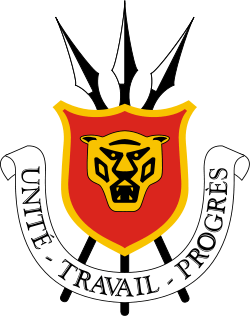Kingdom of Burundi
| Kingdom of Burundi | ||||||
| Royaume du Burundi | ||||||
| Independent state (1680-1885) Part of German East Africa (1885-1916) Part of Ruanda-Urundi (1916-1962) Independent state (1962-1966) | ||||||
| ||||||
| ||||||
| Motto Imana, Umwan, Uburundi Dieu, le Roi et le Burundi "God, the King and Burundi" | ||||||
| Anthem Burundi bwacu (Our Burundi) | ||||||
 Territory of the Kingdom of Burundi in 1966. | ||||||
| Capital | Gitega Bujumbura | |||||
| Languages | Kirundi, French | |||||
| Government | Monarchy | |||||
| Mwami | ||||||
| - | 1680–1709 | Ntare III (first) | ||||
| - | 1966 | Ntare V (last) | ||||
| Prime Minister | ||||||
| - | 1961 | Joseph Cimpaye (first) | ||||
| - | 1966 | Michel Micombero (last) | ||||
| Historical era | Cold War | |||||
| - | Established | 1680 | ||||
| - | German East Africa | July 1, 1890 | ||||
| - | Ruanda-Urundi | July 20, 1922 | ||||
| - | Autonomy | December 21, 1961 | ||||
| - | Independence | July 1, 1962 | ||||
| - | Republic | November 28, 1966 | ||||
| Area | ||||||
| - | 1966 | 27,834 km² (10,747 sq mi) | ||||
| Population | ||||||
| - | 1966 est. | 3,275,000 | ||||
| Density | 117.7 /km² (304.7 /sq mi) | |||||
| Currency | Rupie Belgian Congo franc Rwanda and Burundi franc Burundian franc | |||||
Part of a series on the |
||||||||
|---|---|---|---|---|---|---|---|---|
| History of Burundi | ||||||||
 | ||||||||
| Tutsi / Hutu / Twa origins | ||||||||
|
||||||||
|
||||||||
|
National Council for / Forces for the Defense of Democracy |
||||||||
|
|
||||||||
| Burundi portal | ||||||||
The Kingdom of Burundi existed according to the traditional account from the 16th century until 1966, but it is now thought that the first king began to reign in 1680. Like the monarchy in neighbouring Rwanda it was led by Tutsi kings. The last mwami (ruler) of Burundi was King Ntare V, who was either (according to some reports) murdered at the Ibwami royal palace in Gitega in 1972, or (according to others) fled to exile in West Germany.
Most members of the royal house live in exile in France today. In the 2005 elections, Princess Esther Kamatari ran for president for the Abahuza party ("Party for the Restoration of Monarchy and Dialogue in Burundi"). Supporters argue that a restoration of a constitutional monarchy could help to ease the tensions between the ethnic groups and become a symbol of unity.
The flag of the kingdom contained a karyenda in the center as a symbol of royal authority.[1]
See also
References
- ↑ Guide to the Flags of the World by Mauro Talocci, revised and updated by Whitney Smith (ISBN 0-688-01141-1), p. 153.
| ||||||||||||||||||||||||||||||||||
.svg.png)
